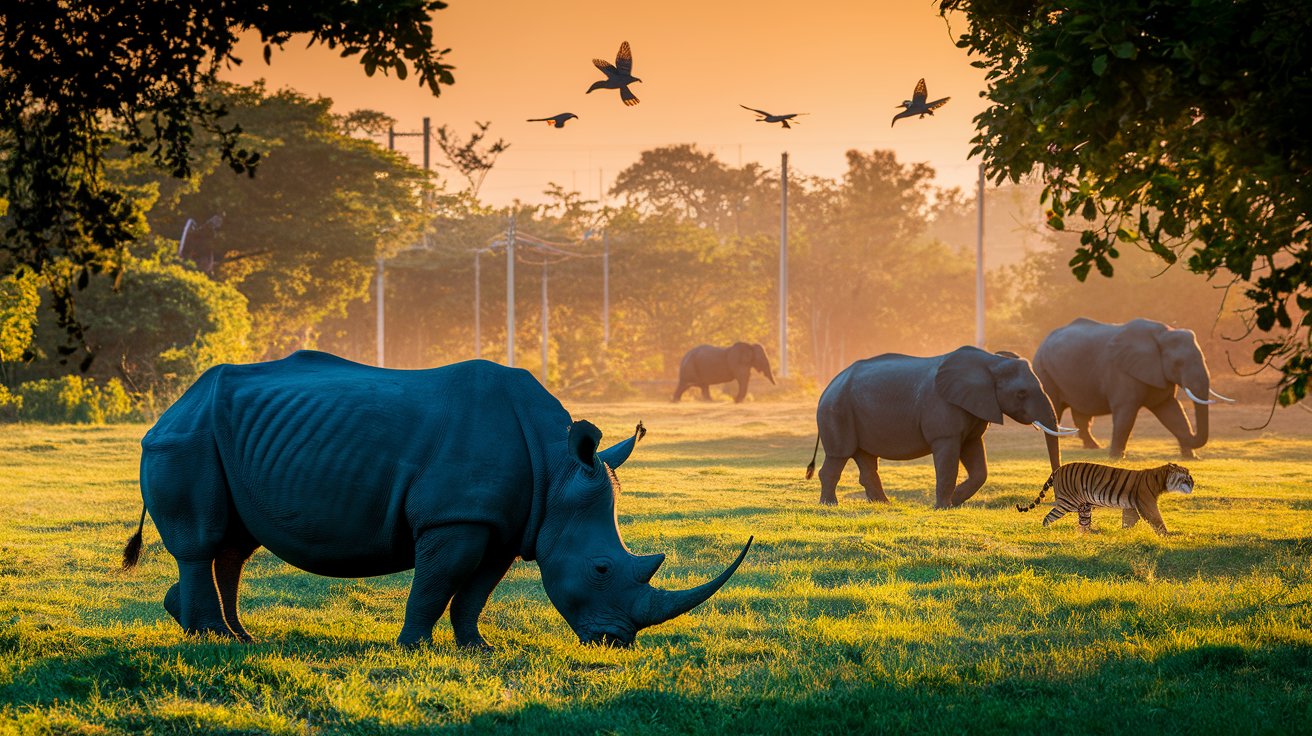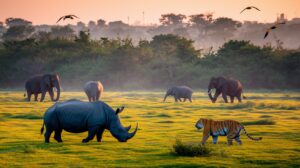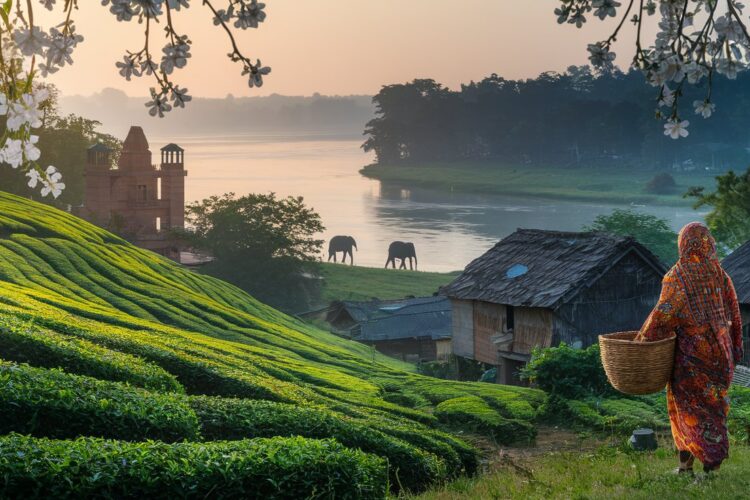
🐘🦏🐯 Picture this: a land where one-horned rhinos roam freely, where majestic tigers prowl through lush forests, and where elephants trumpet their presence across vast grasslands. Welcome to Assam, a biodiversity hotspot nestled in the northeastern corner of India.
Assam’s wildlife is not just a spectacle; it’s a living, breathing testament to nature’s resilience and beauty. But beneath this awe-inspiring surface lies a pressing problem: the delicate balance between human progress and wildlife conservation is under threat. As urbanization creeps into natural habitats and poaching continues to cast its dark shadow, Assam’s unique ecosystem faces unprecedented challenges.
Yet, there’s hope on the horizon. From dedicated conservation efforts to burgeoning ecotourism initiatives, Assam is fighting back to protect its natural heritage. In this exploration of Assam’s wildlife, we’ll delve into the rich tapestry of biodiversity, encounter iconic species, and uncover the ongoing struggle to preserve this ecological paradise. Join us as we embark on a journey through Assam’s wild heart, from its famed one-horned rhinos to its lesser-known, but equally fascinating, flora and fauna. 🌿🦜🐘
Rich Biodiversity of Assam


Diverse ecosystems supporting unique wildlife
Assam’s rich biodiversity is a result of its varied ecosystems, ranging from lush tropical rainforests to expansive grasslands and wetlands. These diverse habitats provide a haven for a wide array of unique wildlife species. The state’s geography, including the Brahmaputra River and its tributaries, creates a mosaic of environments that support different forms of life.
- Key ecosystems in Assam:
- Tropical evergreen forests
- Semi-evergreen forests
- Deciduous forests
- Grasslands
- Wetlands and swamps
Key species found in the region
Assam is home to numerous iconic and endangered species, making it a hotspot for wildlife enthusiasts and conservationists alike. Some of the most notable animals found in the region include:
| Species | Conservation Status | Habitat |
|---|---|---|
| One-horned Rhinoceros | Vulnerable | Grasslands and swamps |
| Asian Elephant | Endangered | Forests and grasslands |
| Bengal Tiger | Endangered | Various forest types |
| Hoolock Gibbon | Endangered | Tropical and subtropical forests |
| Gangetic Dolphin | Endangered | Brahmaputra River system |
Importance of Assam’s wildlife to global conservation
Assam’s biodiversity plays a crucial role in global conservation efforts. The state’s unique ecosystems and endemic species contribute significantly to the planet’s overall biodiversity. Conservation initiatives in Assam have far-reaching impacts:
- Preservation of endangered species
- Maintenance of ecological balance
- Climate regulation through forest conservation
- Protection of vital water resources
As we explore further, we’ll delve into the iconic animals that have become synonymous with Assam’s rich wildlife heritage.
Iconic Animals of Assam
A. One-horned Indian Rhinoceros
The one-horned Indian rhinoceros, also known as the greater one-horned rhinoceros, is the flagship species of Assam’s wildlife. These magnificent creatures are found primarily in Kaziranga National Park, a UNESCO World Heritage Site. Here’s a quick overview of this iconic animal:
- Scientific name: Rhinoceros unicornis
- Conservation status: Vulnerable
- Population in Assam: Approximately 2,650 (as of 2021)
| Feature | Description |
|---|---|
| Weight | 1,800-2,700 kg |
| Height | 1.7-2 meters at the shoulder |
| Horn length | Up to 60 cm |
| Lifespan | 35-45 years in the wild |
B. Asian Elephant
Assam is home to a significant population of Asian elephants, which play a crucial role in the state’s ecosystem and culture. These gentle giants can be spotted in various wildlife sanctuaries and national parks across Assam.
C. Bengal Tiger
The majestic Bengal tiger, India’s national animal, thrives in Assam’s lush forests. Manas National Park and Kaziranga National Park are prime habitats for these striped predators, offering visitors a chance to witness them in their natural environment.
D. Hoolock Gibbon
Assam boasts the only ape species found in India – the hoolock gibbon. These arboreal primates are known for their distinctive calls and acrobatic movements through the canopy of Assam’s evergreen forests.
E. Gangetic Dolphin
The Gangetic dolphin, also known as the South Asian river dolphin, inhabits the Brahmaputra River and its tributaries in Assam. This endangered species is recognized as the state aquatic animal of Assam.
Now that we’ve explored Assam’s iconic animals, let’s delve into the state’s incredible bird-watching opportunities.
Bird Watching Paradise
Kaziranga National Park’s avian diversity
Kaziranga National Park, renowned for its one-horned rhinoceros, is also a haven for bird enthusiasts. The park boasts an impressive array of over 480 bird species, making it a true bird watching paradise. Here’s a glimpse of the avian diversity you can expect:
| Habitat | Bird Species |
|---|---|
| Grasslands | Bengal Florican, Swamp Francolin |
| Wetlands | Bar-headed Geese, Spot-billed Pelicans |
| Forests | Great Hornbill, Oriental Pied Hornbill |
| Rivers | Pallas’s Fish Eagle, Grey-headed Fish Eagle |
Rare and endangered bird species
Assam is home to several rare and endangered bird species, attracting ornithologists and conservation efforts from around the world. Some notable species include:
- Greater Adjutant Stork
- Bengal Florican
- White-winged Duck
- Jerdon’s Babbler
These species face various threats, including habitat loss and human encroachment, making conservation efforts crucial for their survival.
Migratory birds in Assam
Assam’s wetlands and rivers serve as vital stopover points for numerous migratory birds. During the winter months, the state welcomes a diverse array of avian visitors, including:
- Bar-headed Geese
- Northern Pintail
- Greylag Geese
- Ruddy Shelduck
These migratory birds travel thousands of kilometers from their breeding grounds in Central Asia and Siberia to escape harsh winters. The abundance of food and suitable habitats in Assam make it an ideal wintering ground for these long-distance travelers.
Conservation Efforts in Assam
Protected areas and national parks
Assam boasts an impressive network of protected areas and national parks, serving as sanctuaries for its diverse wildlife. The state is home to five national parks and 18 wildlife sanctuaries, covering approximately 3.1% of its total geographical area. Here’s a breakdown of some key protected areas:
| National Park | Established | Key Species |
|---|---|---|
| Kaziranga | 1974 | One-horned rhinoceros, Bengal tiger, Asian elephant |
| Manas | 1990 | Golden langur, hispid hare, pygmy hog |
| Dibru-Saikhowa | 1999 | Feral horses, white-winged wood duck |
| Orang | 1999 | One-horned rhinoceros, Royal Bengal tiger |
| Nameri | 1998 | White-winged wood duck, hornbills |
These protected areas play a crucial role in safeguarding Assam’s rich biodiversity and providing habitats for numerous endangered species.
Anti-poaching measures
To combat wildlife crime, Assam has implemented stringent anti-poaching measures:
- Deployment of armed forest guards
- Use of drones for aerial surveillance
- Installation of camera traps to monitor wildlife movements
- Collaboration with local communities for intelligence gathering
- Establishment of special rhino protection force in Kaziranga National Park
Community-based conservation initiatives
Recognizing the importance of local involvement, Assam has launched several community-based conservation programs:
- Eco-development committees
- Joint forest management initiatives
- Wildlife tourism cooperatives
- Conservation education programs in schools
These initiatives aim to create a sense of ownership and responsibility among local communities, fostering a harmonious relationship between humans and wildlife.
Wildlife rehabilitation programs
Assam’s wildlife rehabilitation efforts focus on rescuing and rehabilitating injured or orphaned animals. Key programs include:
- Centre for Wildlife Rehabilitation and Conservation (CWRC) near Kaziranga
- Mobile Veterinary Service units for rapid response
- Specialized care for orphaned rhino calves and elephant calves
These programs not only save individual animals but also contribute to the overall conservation of vulnerable species in Assam.
Challenges Facing Assam’s Wildlife
Habitat loss and fragmentation
Assam’s wildlife faces significant challenges due to habitat loss and fragmentation. As human populations expand, natural habitats are being converted for agriculture, urbanization, and infrastructure development. This process disrupts ecosystems and isolates animal populations, leading to:
- Reduced living space for wildlife
- Limited access to food and water sources
- Disrupted migration patterns
- Increased vulnerability to predators and poachers
The following table illustrates the impact of habitat fragmentation on Assam’s wildlife:
| Impact | Consequence |
|---|---|
| Reduced gene flow | Decreased genetic diversity |
| Isolated populations | Higher risk of local extinctions |
| Edge effects | Increased exposure to human activities |
| Decreased habitat quality | Reduced carrying capacity |
Human-wildlife conflict
As human settlements encroach upon wildlife habitats, conflicts between people and animals have become more frequent. These conflicts often result in:
- Crop damage by elephants and other herbivores
- Livestock predation by big cats
- Human injuries or fatalities from animal encounters
- Retaliatory killings of wildlife
Climate change impacts
Climate change poses a significant threat to Assam’s wildlife, affecting:
- Seasonal patterns and migration timings
- Availability of food and water resources
- Spread of diseases and invasive species
- Alteration of habitats and ecosystems
Illegal wildlife trade
Despite conservation efforts, the illegal wildlife trade continues to threaten Assam’s fauna. Poaching and trafficking target various species for:
- Traditional medicine
- Exotic pets
- Luxury goods (e.g., ivory, rhino horn)
- Bushmeat
Addressing these challenges requires a multi-faceted approach involving local communities, government agencies, and conservation organizations. With proper management and protection, Assam’s unique wildlife can be preserved for future generations.
Ecotourism Opportunities
Wildlife safaris and nature walks
Assam’s lush landscapes and diverse ecosystems offer unparalleled opportunities for wildlife enthusiasts. Embark on thrilling safaris and nature walks to encounter the region’s iconic fauna in their natural habitats.
Popular safari destinations include:
- Kaziranga National Park
- Manas National Park
- Nameri National Park
- Orang National Park
These parks offer various safari options:
| Safari Type | Description | Best Time |
|---|---|---|
| Jeep Safari | Explore deeper into the park | Early morning or late afternoon |
| Elephant Safari | Get close to wildlife | Morning hours |
| Boat Safari | Navigate river systems | Year-round |
Nature walks provide a more intimate experience with Assam’s flora and fauna. Guided treks through tea gardens and forest trails offer opportunities to spot endemic bird species and smaller mammals.
Responsible tourism practices
Assam’s wildlife sanctuaries promote eco-friendly tourism to minimize environmental impact. Visitors are encouraged to:
- Follow designated trails
- Maintain a safe distance from animals
- Avoid littering and use reusable water bottles
- Respect local customs and traditions
- Support local guides and eco-lodges
Economic benefits for local communities
Ecotourism in Assam creates sustainable livelihoods for local communities. By engaging in wildlife tourism, visitors contribute to:
- Employment opportunities for local guides and park staff
- Support for traditional handicrafts and local products
- Development of community-based tourism initiatives
- Funding for conservation efforts and anti-poaching measures
These economic benefits incentivize communities to protect their natural heritage, creating a win-win situation for both wildlife and people. As we explore Assam’s ecotourism opportunities, it’s crucial to understand the delicate balance between conservation and development.
Flora Supporting Assam’s Fauna
Key plant species in Assam’s ecosystems
Assam’s lush ecosystems are home to a diverse array of plant species that play a crucial role in supporting the region’s rich fauna. Some of the key plant species include:
- Hollong (Dipterocarpus macrocarpus)
- Nahor (Mesua ferrea)
- Gamari (Gmelina arborea)
- Bamboo (various species)
- Orchids (over 250 species)
These plants provide food, shelter, and nesting sites for numerous animals, contributing to the overall biodiversity of Assam.
| Plant Species | Primary Function | Benefits to Wildlife |
|---|---|---|
| Hollong | Canopy formation | Habitat for arboreal species |
| Nahor | Fruit production | Food source for birds and mammals |
| Gamari | Timber and shade | Nesting sites for birds |
| Bamboo | Versatile resource | Food and shelter for various species |
| Orchids | Ecosystem indicators | Attract pollinators |
Importance of forest cover for wildlife
The dense forest cover in Assam is essential for maintaining the delicate balance of its ecosystems. It provides:
- Habitat fragmentation prevention
- Microclimate regulation
- Soil erosion control
- Water cycle maintenance
These factors are crucial for the survival of Assam’s diverse wildlife, including endangered species like the one-horned rhinoceros and Bengal tiger.
Unique adaptations of local flora
Assam’s flora has developed remarkable adaptations to thrive in the region’s specific climate and terrain:
- Flood-resistant root systems
- Broad leaves for maximum sunlight absorption
- Symbiotic relationships with fungi and insects
- Seasonal flowering patterns aligned with animal migration
These adaptations not only ensure the survival of plant species but also provide year-round support for Assam’s fauna, making the region a true biodiversity hotspot.
Assam’s wildlife is a testament to the incredible biodiversity of our planet. From the majestic one-horned rhinoceros to the elusive Bengal tiger, the state’s fauna captures the imagination of nature enthusiasts worldwide. The region’s lush forests and wetlands provide a sanctuary for countless bird species, making it a paradise for birdwatchers. However, this rich ecosystem faces numerous challenges, including habitat loss and poaching.
Conservation efforts in Assam are crucial for protecting these precious species and their habitats. By supporting ecotourism initiatives and sustainable practices, we can contribute to the preservation of Assam’s unique flora and fauna. As visitors and global citizens, we have a responsibility to appreciate and safeguard this natural treasure for future generations. Let’s commit to promoting awareness and taking action to ensure the continued thriving of Assam’s extraordinary wildlife.





